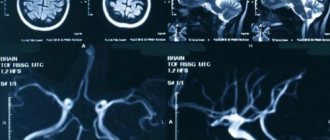Author's rating
Author of the article
Smirnova Olga Leonidovna
Neurologist, education: First Moscow State Medical University named after I.M. Sechenov. Work experience 20 years.
Articles written
94
It is important for everyone to know which part of the brain is responsible for memory and what influences this process. Every day we receive a lot of information, some of which is remembered. Why do some memories remain in memory and others not, what is the mechanism of action of memory?
Where is the memory
Memory is the ability to remember, accumulate and retrieve received information. How much a person can remember depends on his attention.
Memory is formed by several parts of the brain: the cerebral cortex, the cerebellum, and the limbic system. But it is most influenced by the temporal lobes of the brain. The process of remembering occurs in the hippocampus. If the temporal region is damaged on one side, then memory becomes worse, but if there is damage in both temporal lobes, the memorization process stops completely.
The functioning of memory depends on the state of neurons and neurotransmitters that provide communication between nerve cells. They are concentrated in the hippocampus region. Acetylcholine is also classified as a neurotransmitter. If these substances are not enough, then memory deteriorates significantly.
The level of acetylcholine depends on the amount of energy produced during the oxidation of fats and glucose. Neurotransmitters are concentrated in the organ in smaller quantities if a person is stressed or suffers from depression.
Memorization mechanism
The human brain works like a computer. To save current information, it uses RAM, and for long-term storage it cannot do without a hard drive. Depending on how long the part of the brain responsible for memory stores information, there are:
- immediate memory;
- short-term;
- long-term
Interestingly, depending on the species, memory is stored in different parts of the brain. Short-term memories are concentrated in the cerebral cortex, and long-term memories are concentrated in the hippocampus.
The ability to remember is considered an important part of intelligence. Therefore, the amount of information a person owns depends on its development.
The work of memory consists of remembering, storing and reproducing. When people receive information, it travels from one nerve cell to another. These processes occur in the cerebral cortex. These nerve impulses lead to the creation of neural connections. Along these paths, a person subsequently retrieves, that is, remembers the information received.
WE RECOMMEND WATCHING: What to do if you have memory problems?
How successfully and for a long time information is remembered is influenced by the attention with which a person treats the object. If this is interesting to him, then he concentrates more strongly on the subject that interests him and the memorization process occurs at a high level.
Attention and concentration are the functions of the psyche that allow you to focus all your thoughts on a specific object.
No less important than memorization is forgetting information. Thanks to this, the nervous system is unloaded and space is freed up for new information, and new neural connections begin to form.
It is impossible to say for sure which hemisphere is responsible for memory, since both of these areas play an important role in the process of processing and remembering information.
Back Next
Long-term memory is divided into two types that are relatively independent from each other.
Declarative memory (from the Latin declaratio - statement, announcement) - it stores information that a person can potentially present or tell. In turn, in declarative memory there are:
1. Episodic memory - contains memories of events that occurred in a person’s life, episodes of the past (for example, memories of one’s travels, familiar people, classes at school and university, books read, etc.).
2. Semantic memory - contains generalized knowledge about the world: words and their meanings, semantic (semantic) categories, rules, facts, etc. For example, Paris is the capital of France, hallucinations - perception without an object, etc.
Initially, all information is remembered as episodic memory, i.e. in the form of a set of memories about how and when this information was interacted with. Gradually, important, essential information is abstracted from the context and is subsequently stored in semantic memory. For example, for a student, after studying a new topic in class, new knowledge is first intertwined with memories of when and where it was acquired (i.e., where in the textbook they were read or under what circumstances they were heard from the teacher, etc.). Subsequently, these additional circumstances are erased from memory, while the semantic information itself should remain (if enough effort has been spent on memorization). Only the most vivid and emotionally significant memories for the individual remain in episodic memory.
Sometimes they separately distinguish autobiographical memory , which has semantic features (manifests itself, for example, in the creation of a verbally formalized history of one’s life), but mainly episodic memory (representation of episodes of the past).
Non-declarative (procedural) memory - this type of memory provides storage of elements of previous experience not associated with ideas: skills, conditioned reflexes, precedence effect (priming).
Skills _ Any new method of action, proceeding initially as some independent, developed and conscious activity, then, as a result of repeated repetitions, can be implemented as an automatically performed component of the activity. Skills are a special type of memory, since, for example, after acquiring a skill, we are able to restore it quickly enough, even if we have not practiced it for a long time. Skills can be motor (for example, walking, riding a bicycle, tying surgical knots), intellectual (automated techniques for solving previously encountered mental problems) and perceptual (more quickly and subtly understanding familiar material).
All types of long-term memory are involved in the work of a doctor:
- Semantic memory - memory of medical terms, names of drugs, patterns of physiology, pathology, etc.
- Episodic memory is the memory of individual episodes of one’s medical experience, specific cases from one’s practice.
- Non-declarative memory - skills of working with a patient: perceptual (fine perception of signs characteristic of the corresponding diseases, for example, auscultation skills), intellectual (skills of identifying the most important signs, decision making, etc., i.e. what is usually called “clinical thinking” "), motor (direct assistance skills, for example, administering intravenous injections, applying surgical sutures, etc.).
Accordingly: a) a significant part of the medical experience, the “expert knowledge” of the doctor is non-declarative in nature, i.e. cannot be formulated and described by him; b) this creates difficulties in assessing the knowledge of doctors during their assessment and certification. Assessment based only on theoretical knowledge (semantic memory) is insufficient and one-sided. The use of the so-called competency-based approach in education and assessment of this knowledge and skills is more fully consistent with the peculiarities of storing the professional knowledge and skills of a doctor.
Localization of memory in the brain
We can say that there is no single memory center in the brain. Memory is “distributed” throughout the cerebral cortex in accordance with the functions of certain areas of the cortex, i.e., for example, in the motor cortex the memory of movements is stored, in the cortical centers of the analyzers - about the characteristics of the signals perceived by these analyzers, etc. d. Moreover, if in the primary centers of the analyzers and directly in the motor cortex this memory is the most “specific” (i.e., it contains information about individual, private properties of signals, individual movements of specific muscles), then as it moves away from these primary centers, the memory becomes more and more “ abstract" - complex perception of the properties of objects (with the possibility of recognizing them), planning actions, etc. (see figure).
Executive (frontal lobes) and receptive (other lobes) memory https://www.joaquinfuster.com/
Non-declarative memory (skills), in addition to the cerebral cortex, is also ensured by the functioning of the cerebellum and basal ganglia.
Remembering information stored in declarative memory is ensured by the hippocampus . It is assumed that it provides some kind of “coding” of new information, establishing connections with existing information, building cognitive maps and mental models (relationships, including in space, time, etc.).
At what age does a person develop memory? Standard assumption: from 3–4 years old, i.e. from the age that a person can remember (memories of individual episodes of the past and himself in this past). However, in fact, by the age of 3–4 years, the child has already acquired (for the rest of his life!) a significant part of the knowledge about the world around him, but he cannot reproduce information about his life before this age (i.e. information from episodic memory). It is assumed that, on the one hand, until this time, the functioning of his hippocampus does not allow him to sufficiently encode (including using words) and associate complex memories with each other, in addition, he has not yet formed the concept of self-awareness and time, which makes it difficult to attribute of certain memories to one’s past; in addition, further development and restructuring of the hippocampus disrupts the connections on which memories of an earlier age are based. Thus, all this together determines the almost complete absence of memories of one’s early childhood in a person’s adult life, but does not at all indicate a lack of memory in this period.
Information stored in episodic memory is stored in the parahippocompal cortex (medial temporal lobe - neuroimaging sign - medial temporal atrophy, MTA). Since the hippocampus is part of the limbic system, as noted above, highly emotionally charged events are better stored in episodic memory.
Information located in semantic memory is stored in the anterior temporal lobe .
In addition, semantic memory (especially verbal) is more associated with the left (dominant) hemisphere, and episodic memory - with the right. It is assumed that women more often use episodic memory (including emotionally charged), and men use semantic memory.
When performing a functional assessment of brain activity during memory studies (tests) (for example, on functional magnetic resonance imaging), in addition to activation in the temporal lobe, pronounced activity is noted in the frontal lobes, which search and retrieve necessary information from memory.
Confirmation that each type of memory has its own relatively independent neurophysiological basis is provided by observations of patients with isolated brain damage in the indicated locations, leading to corresponding isolated disorders of each type of memory (see below).
Back Next
To see comments you must register










